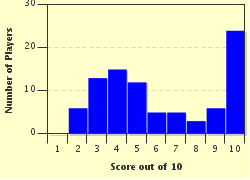Quiz Answer Key and Fun Facts
1. The sculpting of each character or object used in "Claymation" is attached to a wire skeleton. What is this wire skeleton called?
2. Normal "Claymation" films use twenty-four frames per second. What is it called when two frames per shot are shown?
3. There is a smaller variation of clay animation where the clay is heated and then it is filmed with the use of a time-lapse camera. What is the informal name for this heating of the clay called?
4. Which trick film did Edison Manufacturing release in 1908?
5. In 1972, Andre Roche created some clay animation for German television for children. What was this program called?
6. The clay animated work called "Gumby" was created by which man?
7. Some short films using "Claymation" have won academy awards. Which of these was one such film?
8. Who were Wallace and Gromit?
9. What were "The Neverhood" and "Clay Fighter"?
10. Is "Claymation" a registered trademark?
Source: Author
funnytrivianna
This quiz was reviewed by FunTrivia editor
kyleisalive before going online.
Any errors found in FunTrivia content are routinely corrected through our feedback system.

